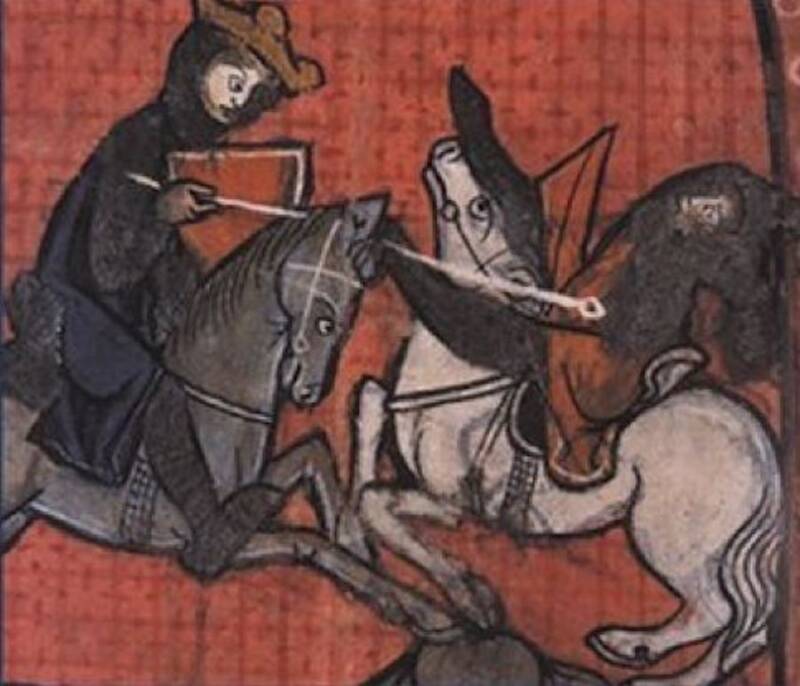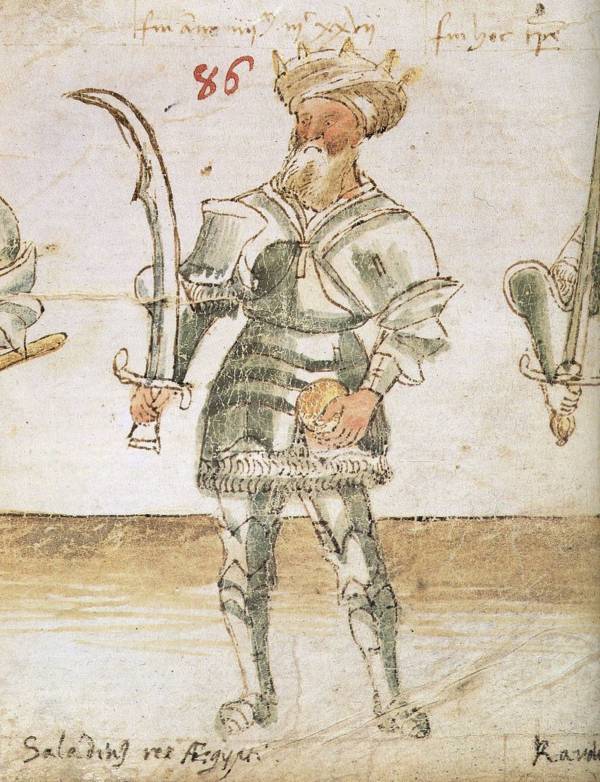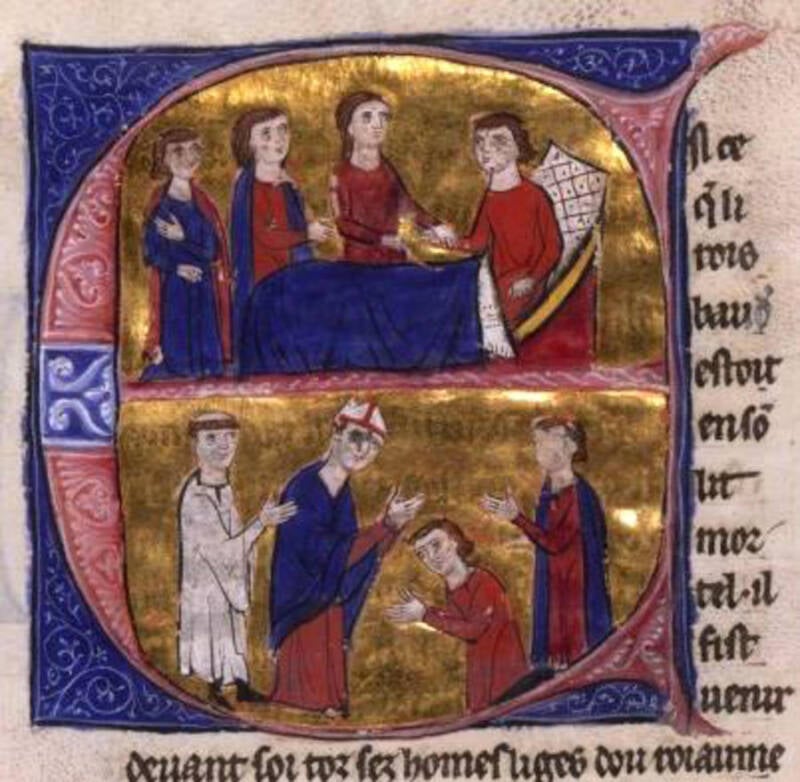While reigning over medieval Jerusalem from 1174 to 1185, King Baldwin IV made a name for himself as a talented leader and a brave soldier despite his leprosy.

Wikimedia CommonsA 13th-century depiction of King Baldwin IV of Jerusalem.
Medieval prince Baldwin IV knew his chances weren’t good when he was diagnosed with leprosy at the age of nine.
Before the (relatively recent) discovery of the cure for leprosy, contracting the disease was as good as a death sentence. Victims of leprosy were not only condemned to a slow and painful demise — they were also shunned by their communities as “unclean” and driven out to live in colonies of the sick and dying, lest they spread their contamination to other people.
But in 12th-century Jerusalem, the young Baldwin IV defied the odds.
Baldwin IV, The Leper King, Discovers His Disease And Takes The Throne
Born to King Amalric I of Jerusalem in 1161, the young prince Baldwin first started showing signs of the dreaded disease at age nine. His tutor, the historian and future archbishop William of Tyre, detected the leprosy when Baldwin, after roughhousing with his friends, reported that he had no feeling in his right arm and felt no pain “if pinched or even bitten.”
After his diagnosis, the boy was protected by his royal position. At a time when kings were viewed as appointed by God, the Frankish court did not force him to live in solitude, much to the astonishment of local Muslims.

Public DomainBaldwin’s tutor, William of Tyre, who realized the boy had leprosy when he was unable to feel pain in his right arm.
Despite his affliction, the young prince demonstrated a sharp mind and proved to be a skilled rider. Shortly after he became a teenager, Baldwin was catapulted into a position of tremendous power after his father’s untimely death in 1174, which turned the sickly 13-year-old into the king of Jerusalem.
This big change came during a pivotal time period. The French had only taken control of Jerusalem 75 years earlier, in 1099, when the First Kingdom of Jerusalem was established in the aftermath of the First Crusade.
Larger than any contemporary European city and of enormous religious importance to both Christians and Muslims, Jerusalem was threatened by the powerful Sultan Saladin nearly as soon as Baldwin IV began his reign.
The Fight For Jerusalem Against Sultan Saladin

Wikimedia CommonsSultan Saladin of Egypt and Syria was King Baldwin IV’s most formidable enemy.
In an age when kings were expected to fight on the front lines, King Baldwin IV did not let his disease get in the way of his royal duties.
The same year he was crowned, the teenage Baldwin organized a successful attack against Damascus as part of his larger strategy to lure Sultan Saladin away from Aleppo. Two years later, he was on the front lines again, leading his troops into battle to fend off Muslim attacks on Damascus and Andujar.
Although he could only hold the reins of a horse with one hand, Baldwin rode at the head of the Frankish army against the Muslim forces in the Battle of Montgisard in Egypt, where they dealt the sultan a surprising blow.
Baldwin’s impressive victories soon made him a hero in the eyes of his people: Their king had managed to overcome his crippling illness to crush one of the most powerful armies in the world and drive back the Muslim threat. He also proved himself as a capable and sensible leader off the battlefield, thanks in part to the help of his trusted advisors.
Aside from his courage as a soldier and his careful strategy as a leader, Baldwin was admired for his lifelong chastity, as people suffering from leprosy were often stereotyped as being sexually deviant or extremely lustful. In retrospect, some historians have suggested that Baldwin may have inspired more tolerance of lepers in Christian communities, though the disease would remain widely stigmatized throughout the Middle Ages.
If Baldwin felt ashamed of his disease, he never let it limit him.
Although the “leper king” has often been popularly depicted as wearing a mask at all times in public to hide his disfigurement, there are no contemporaneous accounts of Baldwin attempting to cover his face. In fact, during the early years of his reign, he showed no outward signs of the disease at all. But near the end of his life, he had developed multiple ulcers and gone blind because of the bacteria from the disease. At that point, he also suffered from frequent fevers and an inability to walk properly.
Far from being shunned and despised because of his worsening affliction, Baldwin IV was only further endeared to his people because of it.
He had led his armies to triumph against a foe with superior numbers through a combination of courage, wit, and tremendous willpower, refusing to let a debilitating disease prevent him from defending his people.

History and Art Collection/Alamy Stock PhotoA depiction of King Baldwin IV’s death in his mid-20s.
Although his wits were still perfectly intact, Baldwin realized his body was finally succumbing to the disease around the age of 24, and he offered to abdicate as his condition deteriorated. Amazingly, his offer was refused, a mark of the tremendous esteem that his people had for him.
Baldwin IV would ultimately remain king of Jerusalem until his death in 1185, ending a reign more successful than anyone had ever expected.
How King Baldwin IV Lives On In Popular Culture

20th Century FoxEdward Norton famously portrayed a masked King Baldwin in the 2005 movie Kingdom of Heaven, but the real Baldwin probably never tried to hide his disfigurement from the public.
In 2005, the film Kingdom of Heaven depicted the Crusades of the 12th century, with Edward Norton starring in the role of King Baldwin IV. The film is largely based on the historical accounts of William of Tyre, the medieval prelate who was also the tutor who first discovered Baldwin’s leprosy.
The initial critical reaction to the film was tepid — historians pointed out that the protagonists had been made significantly less religious and more skeptical than the historical record suggests. King Baldwin IV, for all his heroism, was probably not a humanist or an advocate of religious pluralism.
Pragmatism, however, and sensible leadership did lead Baldwin to make many of the choices we witness in the movie — and his courage on the battlefield and unwillingness to make concessions to his debilitating disease are certainly corroborated in historical accounts.
Baldwin IV also inspired the creators of the popular Darkest Dungeon video games, who crafted a playable character called “The Leper.” The Leper covers his body with armor and conceals his ravaged face behind a mask, and he’s ferocious in battle. His preprogrammed name is “Baldwin.”
After learning about King Baldwin IV, go inside life in old Jerusalem before the state of Israel was created. Then, read about how some Christian artists rewrote history to embrace the image of a white Jesus.





